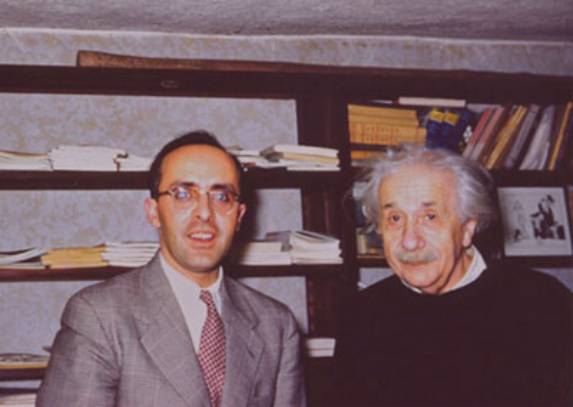"Professor
Mahmood Hesabi was born in Tehran
in 1903 (1281, A.H. Solar). His parents were from Tafresh. At the age of four
his family moved to Syria
and at the age of seven he moved to Beirut
and while tolerating difficult situations and poverty he started his education
at elementary school far from the home land in a French Priests" School. At the
same time, his mother, Gohar Shad Hesabi, who was dedicated, religious and
knowledgeable woman, started teaching him Persian Literature and religious
education.
Hesabi memorized Quran and he had very strong belief in it. He also memorized
Hafez"s Diwan and had completed proficiency in Saadi"s Bustan and Golestan,
Ferdowsi"s Shahname, Molavi"s (Rumi"s) Masnavi and Ghaem Magham"s Monshaat.
The beginning of his guidance school coincided with the start of the World War
I when the French schools of Beirut
were closed. After two years of studying at home he prosecuted his studies at American University
of Beirut and
obtained his BA in Literature at the age of 17, and at the age of 19 he got his
BA in Biology. Then he obtained a degree in engineering and earned money as a
draftsman and a civil engineer. Hesabi also studied Medicine, Mathematics and
Astrology.
In order to appreciate Hesabi, the civil engineering company that he was
working there dispatched him to France
for prosecution of studies. He was admitted to the "Ecole Superieure
d"Electricite" in 1924 and graduated in 1925. Concurrent with studying
mineralogy he was hired by the French Electric Railway Co. and after graduation
in this field he started his work in Iron mines of north of France and Coal
mines of the state of "Sar".
Since he had a scientific mind and spirit he continued his studies and research
in Physics at Sorbonne
University. He obtained
his PhD IN Physics with an excellent degree at the age of 25. The title of his
dissertation was "Sensitivity of Photo Electric Cells".

At that time when 15 thousand people were volunteers to attend Einstein"s
class he had the chance to be one of the 5 chosen ones. He had a meeting
with Einstein at Princeton in American and one
year later he presented a theory called "Infinitely Extended
Particles". By the help and guide of Einstein and his own research in Chicago University
he was able to defend his theory and explain it to other great scientists such
as Born, Mezmi and Schrodinger and he was awarded the medal of the
"Commandeur De La Legion D"honneure", France"s greatest scientific medal.
When he returned to Princeton, Einstein
elected him as a substitute of himself at this university and it was a very big
honor that he received.
The following are some of his accomplishments in scientific fields:
Founding modern sciences, founding "Teachers" College" (Dar-ul
Moallemin), construction of the first radio-set in Iran, founding higher
college for teachers and teaching Physics and Mechanics there, construction of
the first weather-station, installation and operation of the first radiology
center (for his brother Dr. Mohammad Hesabi), establishing Persian Language
Academy, Topography, founding Tehran-Shemshak Railway, founding Tehran
University and acting as the dean and the instructor of the university,
founding applied optic and lens-making center at Tehran University,
establishing the first modern observatory in Iran, establishing nomad school in
the country, establishing Geophysics Society of Iran, founding the atomic
research Center and Atomic Reactor of Tehran University, founding modern center
for satellite studies in Shiraz, founding Physics Society of Iran and etc.
While serving the country during this period he continued his scientific
cooperation such as membership of Oslo Mathematics Congress in Norway,
membership of Princeton scientific conference, membership of research team at
Institute of Nuclear Research of Chicago, membership of New York Science
Academy, membership of Geneva Atomic Conference, membership of Physics Society
of Europe and America, etc.
He spoke five living languages Persian, French, English, German and Arabic and
he also knew Sanskrit, Latin, Greek, Pahlavi, Avestan, Turkish and Italian
which he used for his etymological studies.
He was chosen as the Man of Science in the World in 1989. On 3rd of September,
1992 (12th of Shahrivar 1371, A.H. Solar) at 7:30 am (still a university
professor at Tehran University) he passed away in hospital of Geneva University
after a period of illness."
Source: Iran
Air In flight Magazine, No. 36, Oct- Nov, 2005.
By the way, "Professor Hesabi was the only Iranian student of Professor
Albert Einstein and was known to be his favorite student. During his years of
scientific research he met many distinguished scientists such as Erwin
Schrodinger, Max Born, Enrico Fermi, Paul Dirac, and Aage Niels Bohr and
scholars such as Bertrand Russell and Andre Gide."
Source: Wikipedia